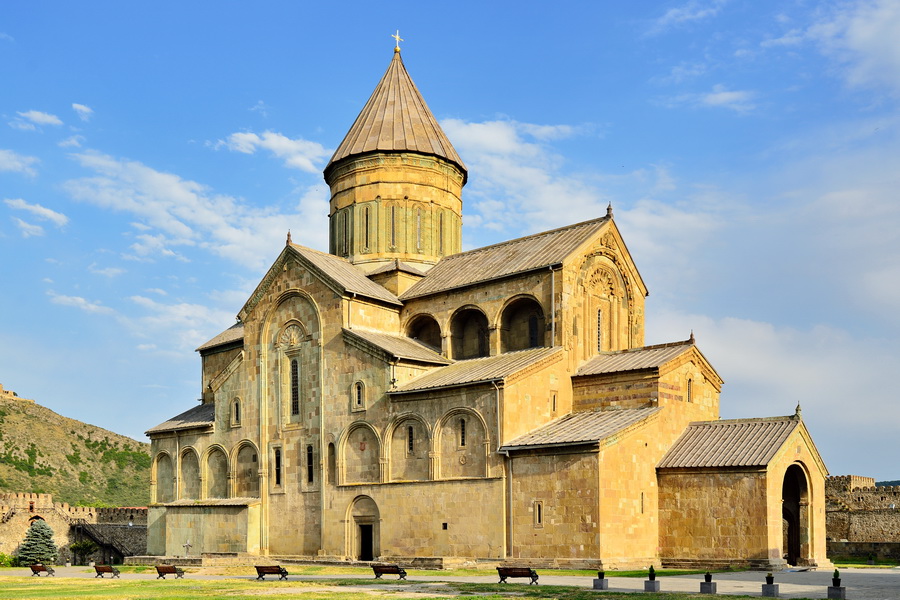Among the must-see places to visit in Georgia are the majestic Narikala Fortress in Tbilisi, the colorful wine-growing region of Kakheti, the Gergeti Monastery set against the breathtaking backdrop of Mount Kazbek, the ancient cave town of Uplistsikhe, and the glittering beaches of Batumi on the Black Sea. These remarkable destinations promise to enchant even the most sophisticated travelers. Check out the top 15 places to visit in Georgia to make your trip truly unforgettable!
Old Tbilisi
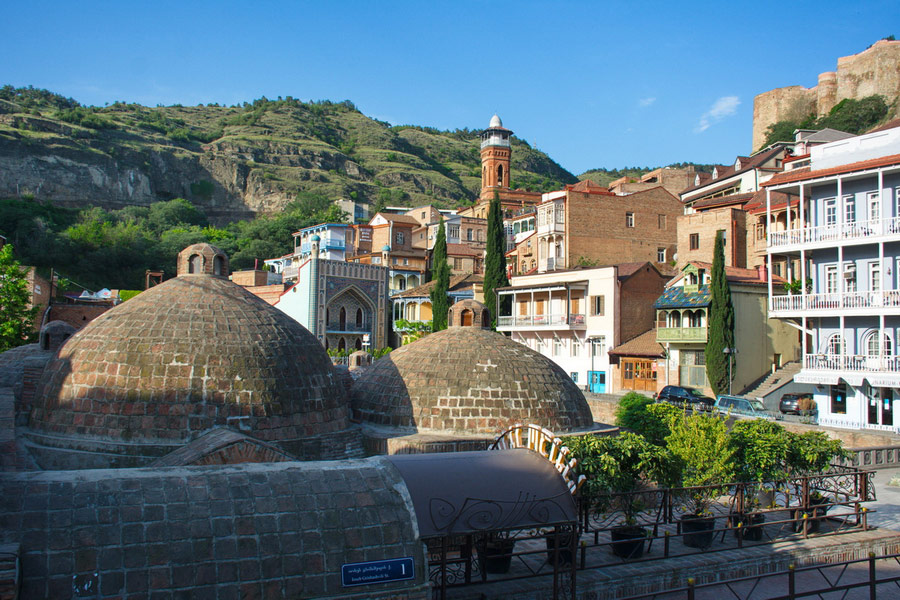
Old Tbilisi is one of the most iconic places to visit in the Georgian capital and a hub of its top attractions. The neighbourhood’s narrow, winding streets are lined with charming brick houses adorned with carved balconies, gradually ascending the slopes of the Sololak Ridge to the imposing Narikala Fortress, which offers panoramic views of the city. Within Old Tbilisi, visitors can explore the historic Sulphur Baths, the ancient Metekhi Temple, the serene Tbilisi Botanical Garden, and the contemporary Peace Bridge. Just a short stroll away, Shardeni and Kote Abkhazi streets invite you to enjoy cosy restaurants, wine boutiques, and unique souvenir shops. The area is also home to the enchanting Gabriadze Puppet Theatre. As the vibrant heart of the city, Old Tbilisi seamlessly blends history with modernity, perfectly capturing the essence of Georgia's capital.
Mtskheta
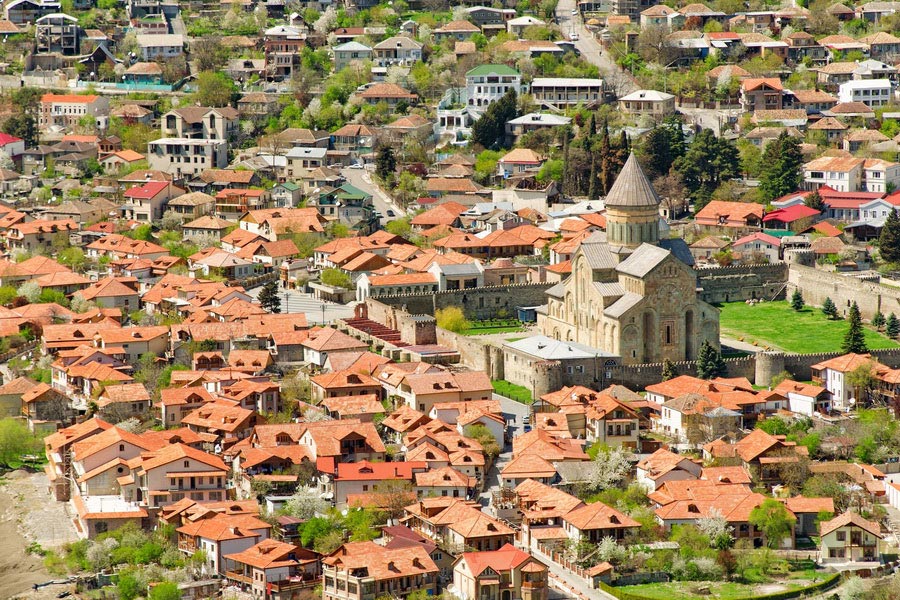
Mtskheta, the ancient capital of Georgia and a prominent spiritual hub, lies just 20 km from Tbilisi. This historic town is renowned for its exceptional monuments, many of which are listed as UNESCO World Heritage Sites. The 11th-century Svetitskhoveli Cathedral captivates visitors with its stunning frescoes and revered Christian relics, while the nearby Samtavro Monastery holds a sacred connection to St. Nino, the bringer of Christianity to Georgia. Towering atop a hill, the 6th-century Jvari Monastery offers a commanding presence and breathtaking views. Mtskheta serves as a vital pilgrimage site, drawing worshippers and visitors from across Georgia and around the globe.
Ananuri Fortress
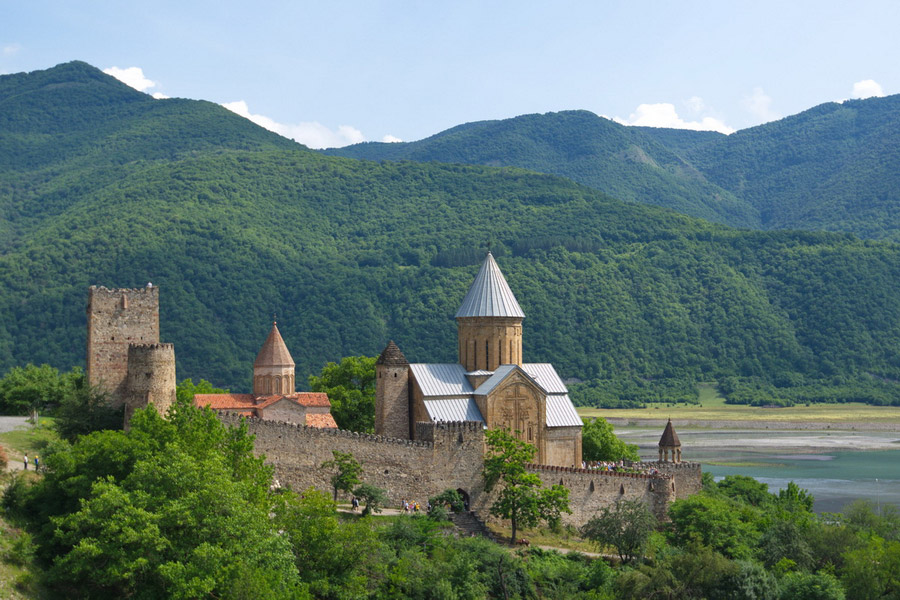
Ananuri Fortress, an architectural gem on the shores of the stunning Zhinvali Reservoir, is one of the top places to visit in Georgia. Renowned for its exceptional preservation, this historic complex features multiple temples and towers, some dating back to the 13th century, with additions from later periods. The centerpiece of the fortress is the Church of the Assumption, its exterior walls adorned with intricate bas-reliefs and its interior decorated with frescoes of the 13 Assyrian Fathers. Visitors can climb one of the fortress towers for a breathtaking panorama of the ancient structures set against the tranquil blue waters of the reservoir, offering a perfect glimpse into Georgia's rich history and natural beauty.
Gergeti Trinity Church
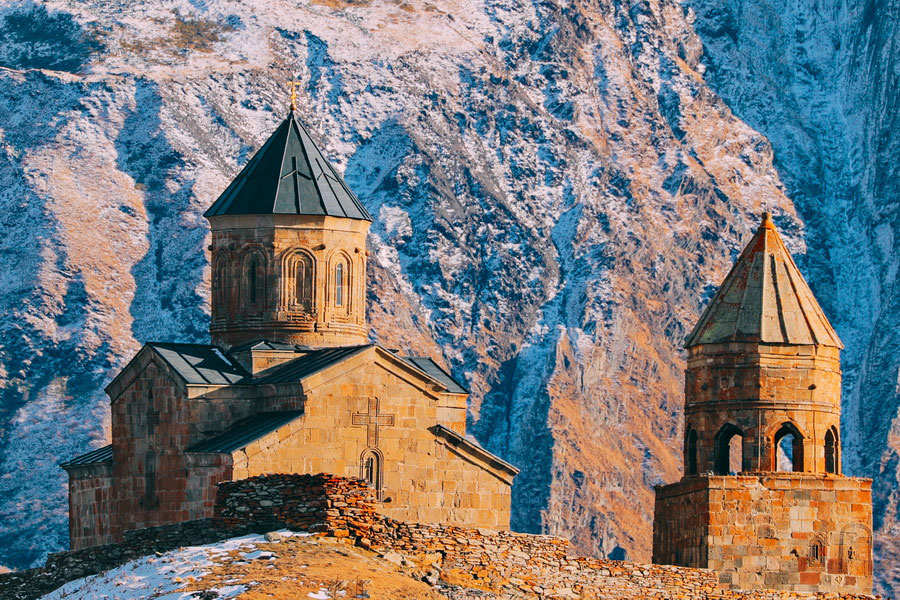
Gergeti Trinity Church, perched above the village of Stepantsminda, is among Georgia's most revered spiritual landmarks. Situated at the foot of Mount Kazbek at an altitude exceeding 2,000 meters, this 14th-century church has served as both a monastic center and a sanctuary for precious relics during enemy attacks on Tbilisi and other Georgian monasteries. Its majestic location atop a mountain peak offers breathtaking views of Kazbek on clear days. Visitors can reach Gergeti Monastery by car or enjoy a scenic hike from the village of Stepantsminda.
Uplistsikhe
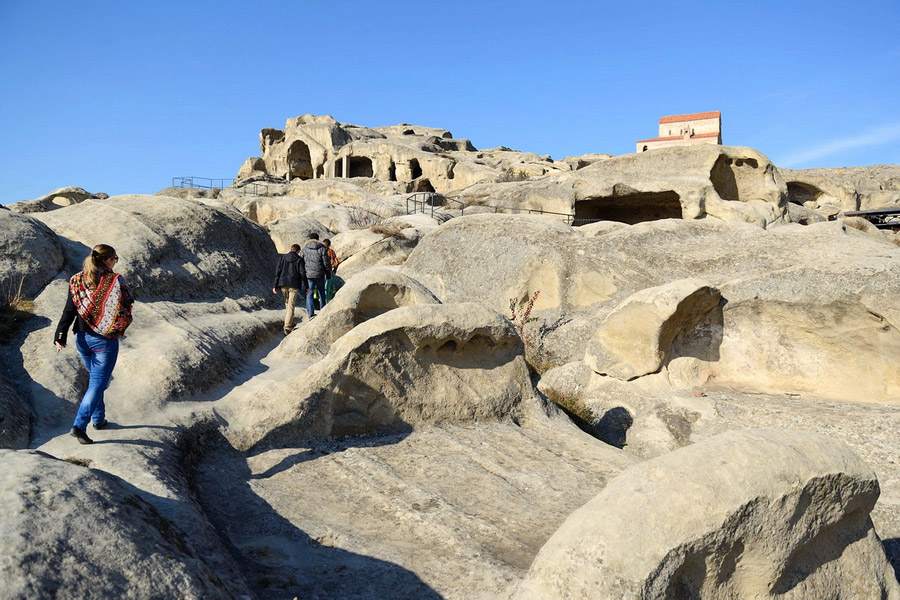
Uplistsikhe, an ancient pagan center of Zoroastrianism and fire-worship, is a remarkable city carved into soft tuff stone over 2,000 years ago and one of the top places to visit in Georgia. This extraordinary archaeological site features temples, palaces with reception halls, sacrificial sites, and sanctuaries dedicated to deity worship. Within its sprawling territory, archaeologists have uncovered streets, a central square, dwellings, wine cellars, libraries, and secret underground tunnels. Out of the 700 original caves used as public spaces and homes for residents, 150 grottoes remain preserved today. A visit to Uplistsikhe offers a rare glimpse into the cultural heritage of ancient civilizations and their lasting influence on modern Georgia.
Vardzia
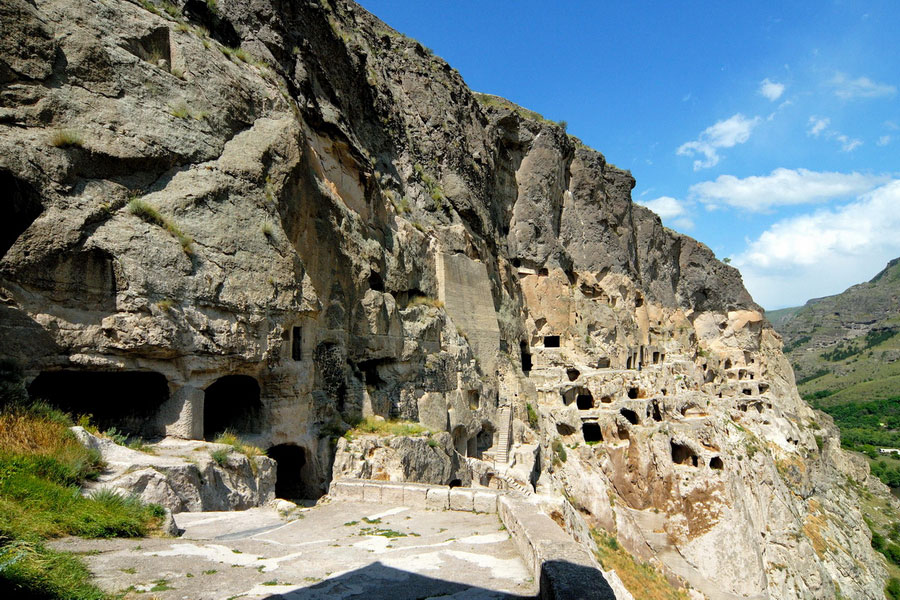
Vardzia is a stunning cave monastery complex carved into the rock during Georgia's Golden Age, closely associated with the reign of Queen Tamar in the 12th century. As one of the most remarkable places to visit in Georgia, the complex encompasses around 600 rooms, including temples, living quarters, storerooms, refectories, wine cellars, and defensive structures. Its centerpiece is the Church of the Assumption of the Virgin Mary, adorned with frescoes, including depictions of Queen Tamar herself. A network of underground passages and tunnels connected various parts of the complex, serving as a secure refuge against invaders. Vardzia was abandoned in the mid-16th century after invasions by the Persians and Turks, marking the end of monastic life and initiating the site's 250-year decline.
Borjomi
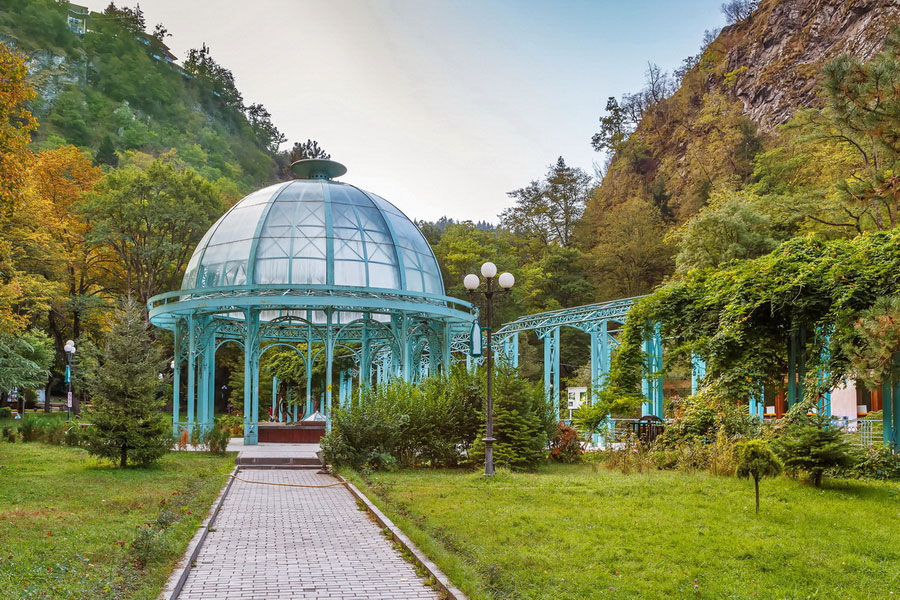
Borjomi is a popular resort town celebrated for its mineral waters with therapeutic properties. The Borjomi springs date back to antiquity, but it was in the 19th century that the town gained prominence across the Russian Empire, becoming a favored destination for the royal family due to its healthful climate. Borjomi is also home to Borjomi-Kharagauli National Park, one of Europe’s largest, featuring well-developed trekking and hiking routes. The town boasts preserved architectural gems such as the Lycan Palace, Mirza Riza Khan's house, and the historic City Council building. Visitors can also enjoy Borjomi’s iconic mineral water springs, conveniently located in the heart of the city.
Sighnaghi
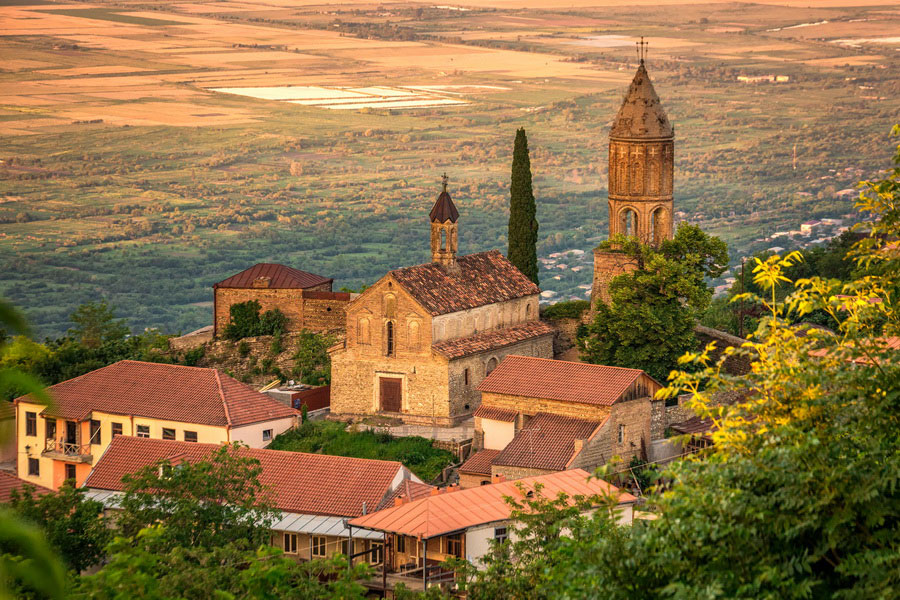
Sighnaghi, a charming town in Kakheti often called the "city of love," is one of the most delightful places to visit in Georgia and a hub of Georgian wine production. Known for its narrow streets, houses adorned with carved balconies, and sweeping views of the Alazani Valley, Sighnaghi offers a unique blend of romance and tradition. The town's centerpiece is its 18th-century fortress wall, complete with 23 towers, which visitors can explore on foot. Nearby, you’ll find the Niko Pirosmani Museum, dedicated to the famous Georgian artist, and just two kilometers away is the Bodbe Monastery, a revered pilgrimage site. For those seeking a touch of spontaneity, Sighnaghi also features a marriage registration center where couples can tie the knot any time of day.
David Gareja Monastery
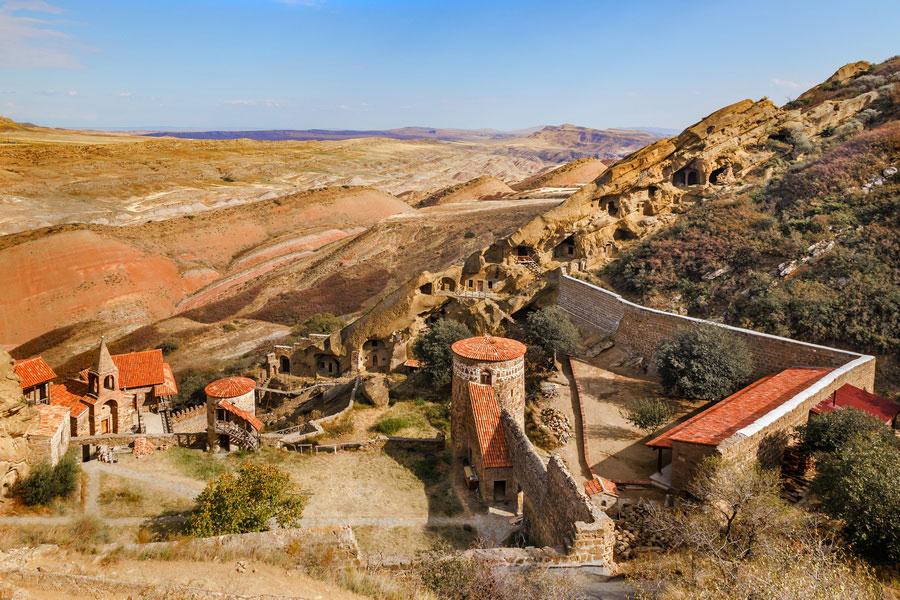
David Gareja Monastery, a unique cave complex in southeastern Georgia and one of the top places to visit in Georgia, was established in the 6th century by David of Gareja, one of the Assyrian fathers. This extraordinary site consists of numerous monasteries carved into the rocky cliffs, with the Lavra of St. David serving as its centerpiece. The monastery also includes cave temples, monks' cells, refectories, and wine storage rooms, all ingeniously integrated into the steep slopes.
Visitors can admire ancient churches adorned with frescoes depicting Gospel stories and scenes from the lives of saints, which have withstood the test of time. For centuries, the David Gareja Monastery has been a significant spiritual and cultural hub, attracting pilgrims from across Georgia. Its timeless architecture and sacred history continue to inspire awe in all who visit.
Martvili Canyon
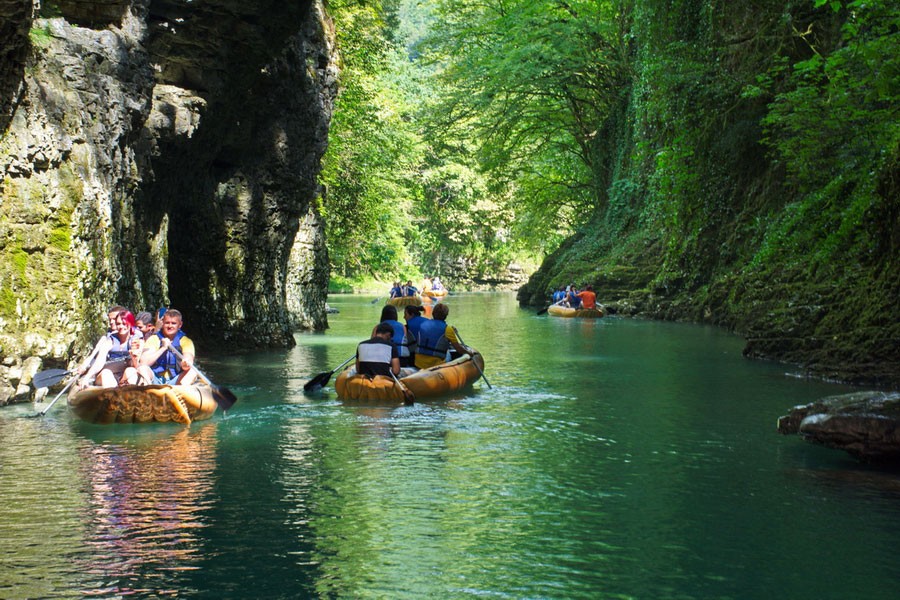
Martvili Canyon, located in western Georgia, is a breathtaking natural wonder renowned for its vibrant turquoise waters and lush green gorges. This stunning site invites visitors to embark on a boat ride along the Abasha River, navigating through waterfalls and towering cliffs that date back millions of years.
With a depth reaching up to 40 meters and a length of 2.4 kilometers, Martvili Canyon offers a unique opportunity to immerse yourself in Georgia's natural beauty. For thrill-seekers, a zipline spans the canyon, providing an exhilarating aerial view of this remarkable landscape.
Prometheus Cave (Kumistavi)
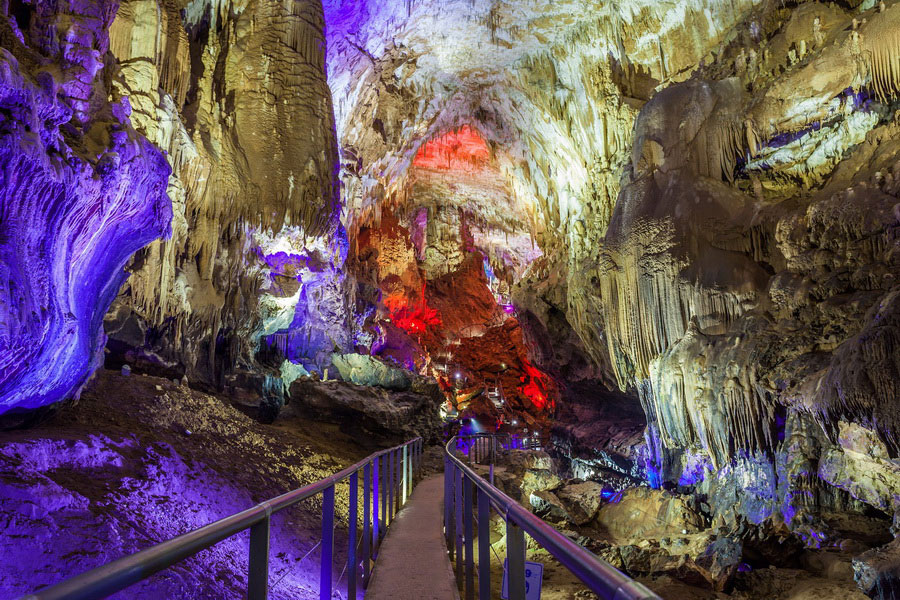
Prometheus Cave (Kumistavi), located in Imereti near the city of Kutaisi, is one of Georgia's largest and most spectacular caves. Discovered in 1984, the cave extends for an impressive 11 kilometers, with approximately 1.5 kilometers open and equipped for tourist exploration.
Inside, visitors are treated to breathtaking views of stalactites, stalagmites, underground rivers, and lakes, all enhanced by vibrant multi-colored lighting and atmospheric musical accompaniment. The cave offers a walking route through its awe-inspiring galleries and the unique opportunity to take a 15-minute boat ride along the underground river. Guided tours are available, making it easy to explore this remarkable natural wonder.
Dadiani Palace
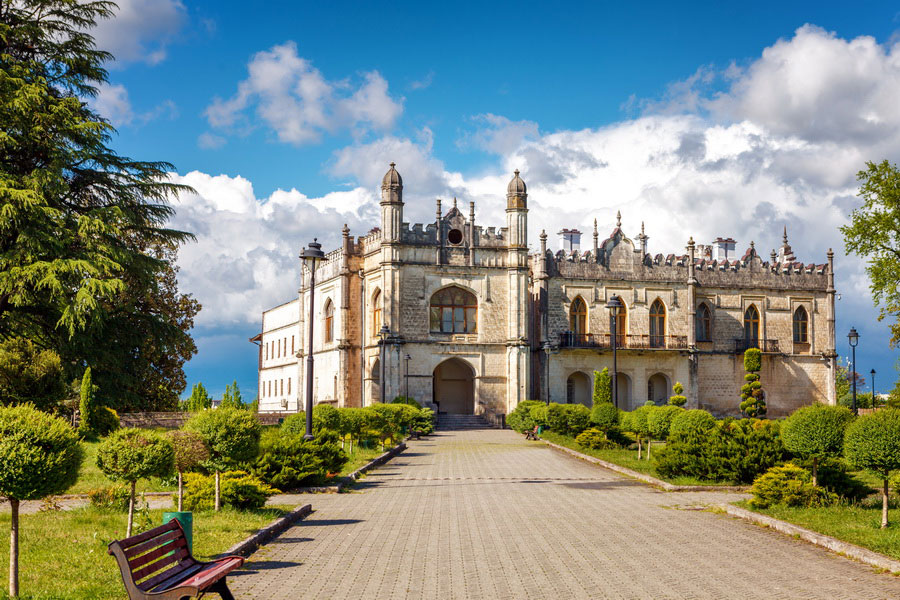
The Dadiani Palace, a historical complex in the Samegrelo region's town of Zugdidi, is among the most fascinating places to visit in Georgia. Constructed in the 19th century, it served as the residence of the influential Dadiani family, Georgian princes who played a pivotal role in the country’s history.
The palace’s architecture is a unique blend of European and Georgian styles, incorporating eclectic and neo-Gothic elements. Inside, visitors can explore an extensive collection of historical artifacts, including personal belongings of the Dadiani family, ancient manuscripts, and even a posthumous mask of Napoleon, brought from France by Prince David Dadiani.
Adding to the palace’s allure is the surrounding lush botanical garden, offering a serene atmosphere and complementing the site’s historical significance. The Dadiani Palace stands as a cultural gem, embodying the rich heritage and captivating history that define the attractions of Georgia.
Svan Towers
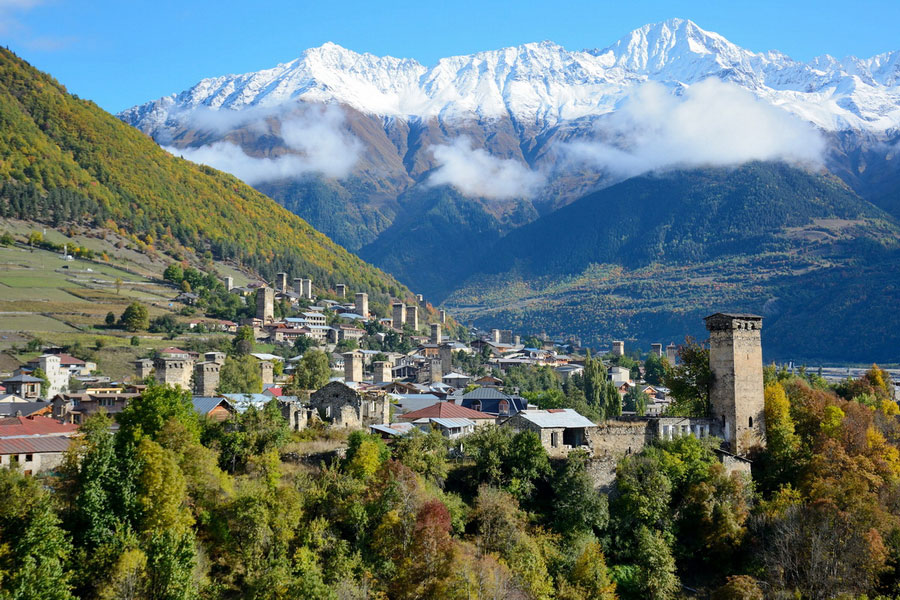
The Svan Towers are unique stone defensive structures in the high mountains of Svaneti, northwest Georgia. Built between the 9th and 13th centuries, these towers served to protect families from raids and enemy attacks while also functioning as living quarters. Each tower, standing 20-25 meters high, has multiple levels with narrow windows and thick walls designed for defense.
The towers are a symbol of Svan culture and architecture, preserved almost unchanged through centuries. Recognized for their historical value, the Svan Towers are included in the UNESCO World Heritage List, highlighting their importance as part of Georgia’s rich cultural heritage.
Batumi Embankment
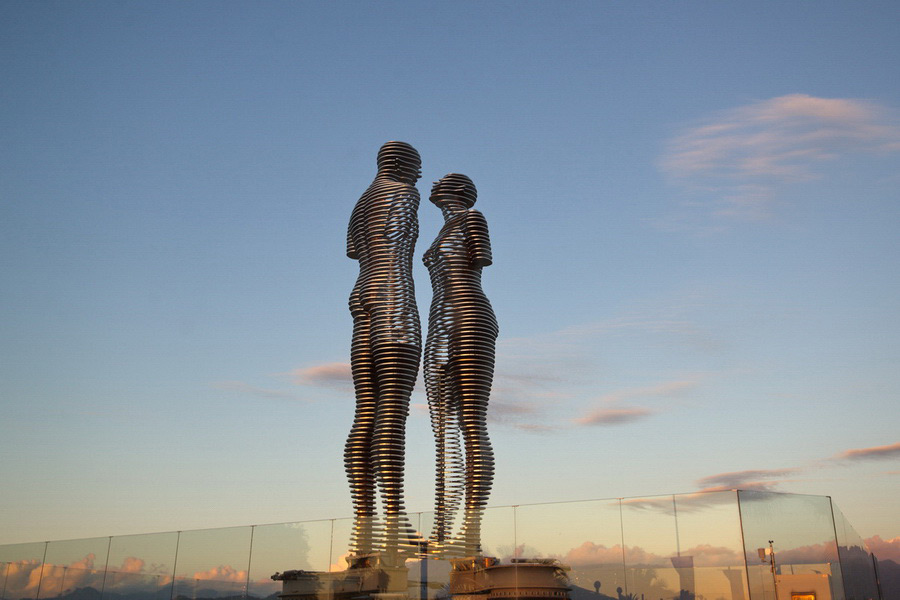
The Batumi Embankment is a vibrant symbol of modern Georgia and one of Batumi’s main places to visit. Stretching nearly 7 kilometers along the Black Sea coast, it offers a mix of relaxation and entertainment, with cozy cafes, restaurants, fountains, and unique art installations. Among its highlights are the iconic sculpture Ali and Nino, symbolizing love and unity, as well as the Batumi Lighthouse, the Alphabet Tower, and a Ferris wheel that provides panoramic views of the city and sea.
The embankment features bike paths, benches, and lush green parks, creating an ideal space for locals and tourists to unwind and enjoy Batumi’s coastal charm.
Batumi Botanical Garden
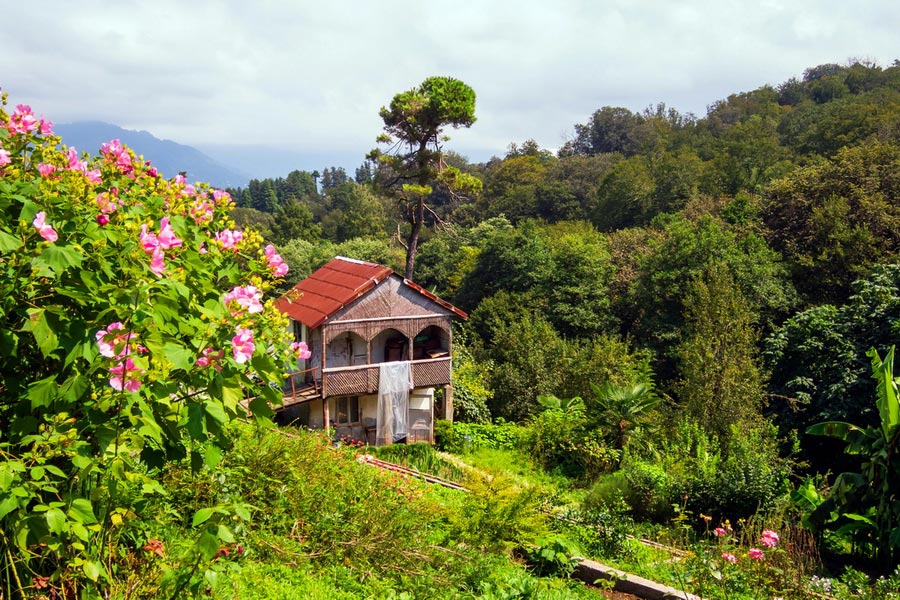
Batumi Botanical Garden, one of the largest botanical gardens in the world and a top place to visit in Georgia, is located just 9 kilometers from Batumi along the Black Sea coast. Established in 1880, it spans over 100 hectares and features nine floristic zones showcasing vegetation from regions such as the Himalayas, Australia, Mexico, and the Mediterranean. The garden is home to around 5,000 plant species, including rare and exotic varieties like palm trees, bamboo, cypresses, and unique flowers.
This stunning garden is a must-see destination for leisurely walks, offering visitors the chance to connect with nature while enjoying breathtaking views of the sea and surrounding mountains.
More Things to See in Georgia
The above-mentioned places to visit in Georgia are among the most popular in the country. However, there are dozens of other remarkable places that leave vivid impressions. Some of these hidden gems are highlighted below.
Chiatura is a small, colorful town in western Georgia, renowned for its mines and unique ropeway system. During Soviet times, Chiatura was a major industrial hub, and its cable cars served as vital transportation for miners and residents navigating the steep slopes of the region.
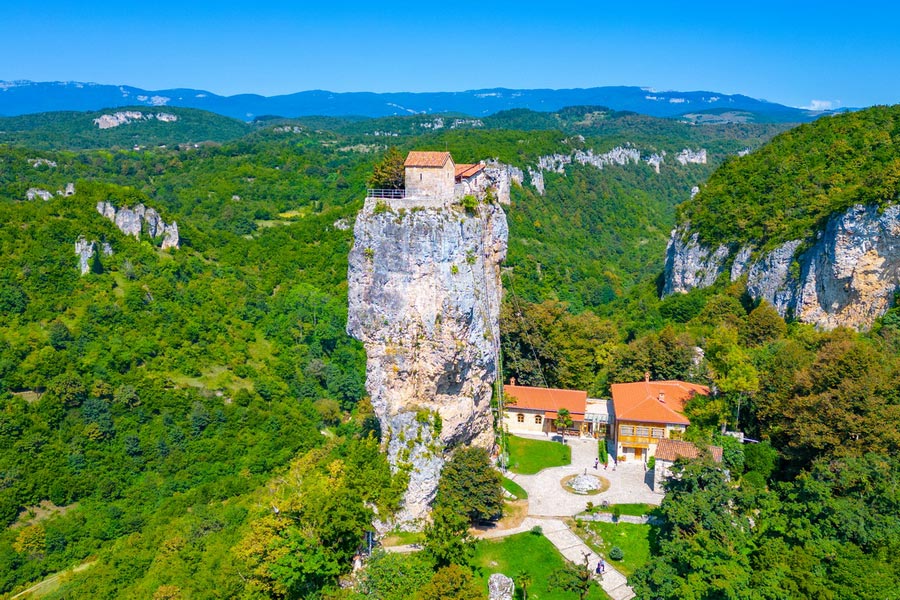
Nearby, you'll find another fascinating attraction — the Katskhi Pillar. This 40-meter limestone monolith is crowned by an ancient church, symbolizing spiritual solitude. For centuries, it has been a place of prayer and worship, set in a serene, isolated landscape surrounded by endless mountain views.
Rabat is a magnificent fortress located in the city of Akhaltsikhe in southern Georgia. Once a semi-abandoned citadel, it has been transformed through extensive restoration into one of the most popular places to visit in Georgia, drawing thousands of visitors annually.
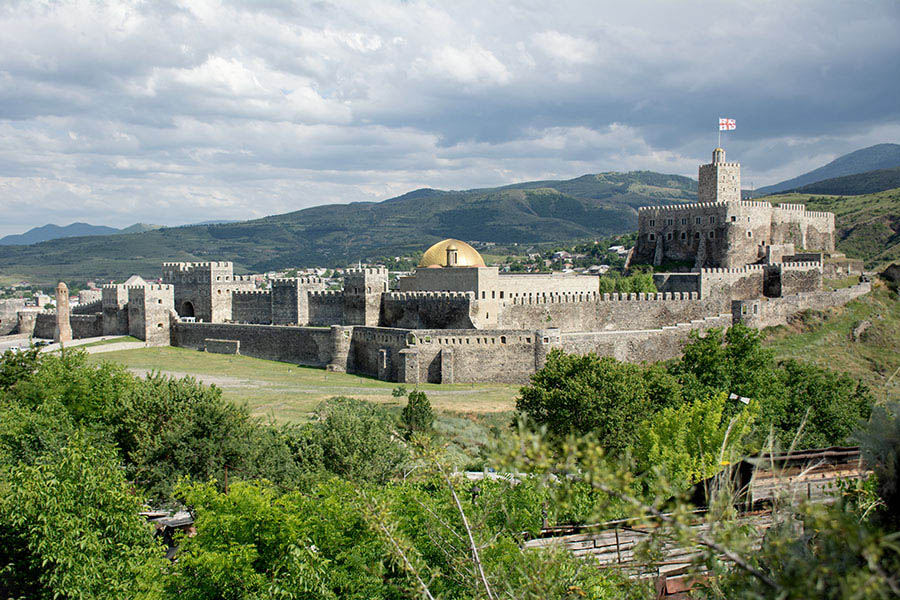
The fortress now houses a museum, vibrant galleries, and panoramic platforms offering breathtaking views of the surrounding landscapes. Visitors can wander through the fortress grounds, discovering various vantage points and immersing themselves in the historical and architectural splendor of this unique site.
Okatse Canyon, located in the Imereti region, is among the most impressive natural attractions of Georgia. Stretching about 16 kilometers, the canyon is renowned for its breathtaking suspension bridge, which soars approximately 140 meters above the gorge and features a viewing platform offering panoramic vistas of lush, forested mountains.
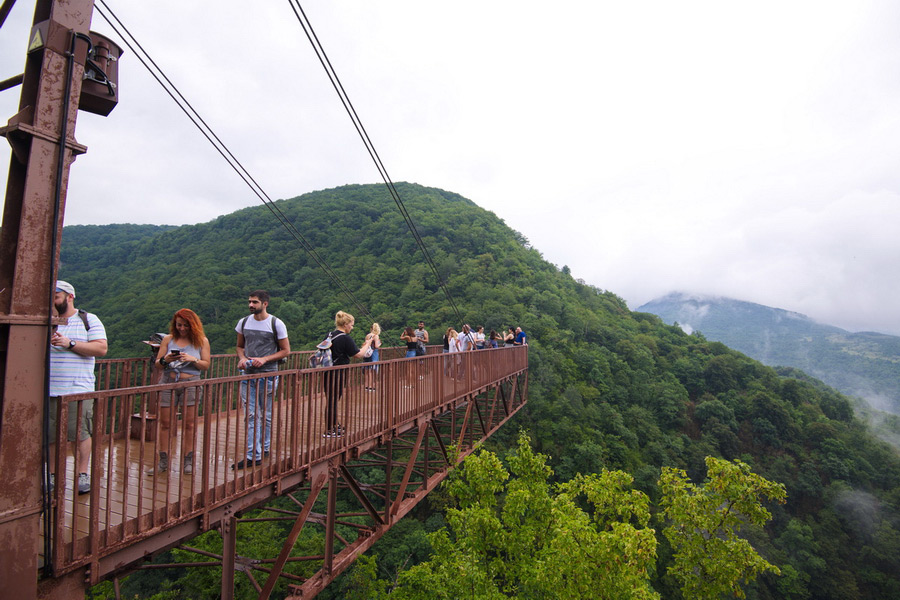
For the convenience of visitors, the canyon is equipped with well-maintained walking paths featuring high safety rails and strategically placed observation terraces along the route. These amenities make exploring Okatse Canyon a rewarding and safe experience for hikers and nature enthusiasts alike. With its breathtaking scenery and unique features, Okatse Canyon is a perfect addition to the list of must-see places to visit in Georgia.


